This is the start of your horse’s ridden career – so it is important to get it right from the beginning. Follow each season with 3 year old Raffles and learn how to safely back your horse, from the first wobbly steps, to working beautifully under saddle… and all the growing up in between!
with Raffles
3 year old Raffles is starting his ridden career. Follow each season right from the beginning.
Scroll through each season!
Spring
Summer
Autumn
Winter
Spring Season
We're off to a great start, despite the windy Spring weather! In this first season your horse will learn to stay relaxed whilst mounting and taking their first steps under saddle.
Download our quick reference cards for each lesson to keep you and your horse on track!

Spring: Lesson 1
Safe Zone
- Equipment
- Headcollar
- Saddle
- Headslip
- Snaffle bit
- Triangle cones
- Targeting
- Pattern recognition
- Confidence
This 'triangle' will help your horse feel relaxed and confident in the arena.
We start this lesson with a few pointers on equipment. Our rider, Maz, is wearing a hat, body protector and gloves. Raffles is in a good strong flat head collar. He has recently had a saddle fitting in our faithful old jumping saddle. This flat seat is best as we will be ‘leaning over’ in the beginning. It also offers a more secure seat with the rider’s leg more forward. We don’t use a bridle at this stage. Instead we add a 'head slip' with a snaffle bit, which easily fits on top of the head collar. Finally, you will see we attach the lunge line to the head collar under the chin.
We have set out a triangular ‘safe zone’ in the arena using traffic cones. Our aim is to mirror the ground work lesson 'targeting' each cone. By doing this we are setting up a pattern for Raffles to learn which you will see we will use to our advantage in the next lesson.
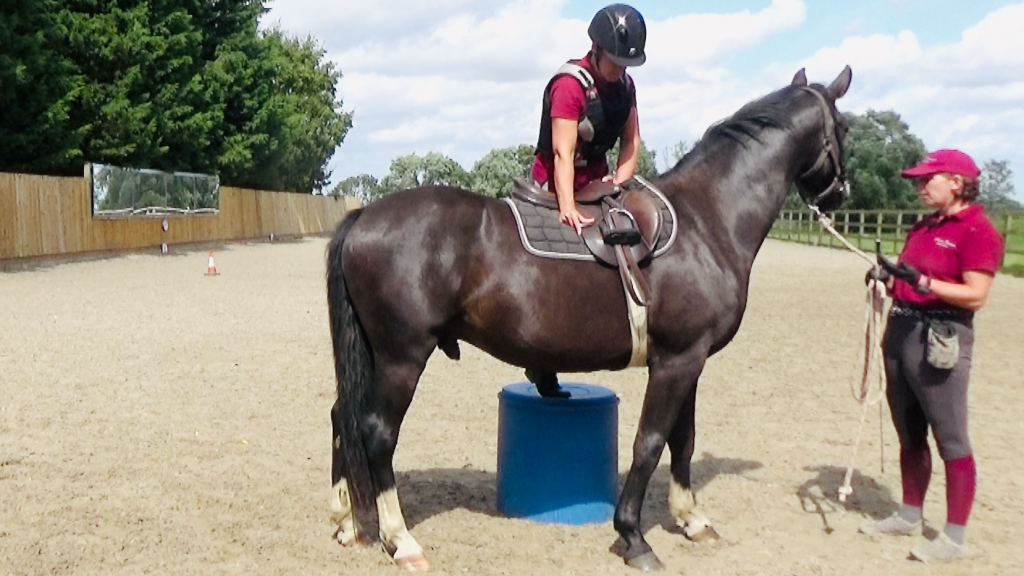
Spring: Lesson 2
Lean Over
- Desensitising
- Mounting block
- Neutral place of relaxation
- Pattern recognition
- Reset button
- Set up for success
Raffles is already enjoying the backing process - it feels more like a game!
In the first lesson we set up a ‘safe zone’ in the arena using cones set out on a triangle. Now we’re ready to start introducing our rider. You’ll see we do this very gradually in steps starting with desensitising using sound, visual and tactile stimulation and then finally Maz, was able to 'lean over' and put her whole weight on Raffles back.
Every time we complete a step and ask a little bit more, we take Raffles away from the 'pressure' of the mounting block and we repeat the previous lesson - targeting the cones on our triangle. This pattern will give your horse confidence. It is really important as it teaches them how to 'reset' themselves, diffusing any tension that might be creeping in, and it helps to keep them focused and paying attention. Raffles is already enjoying the process as it feels more like a game!
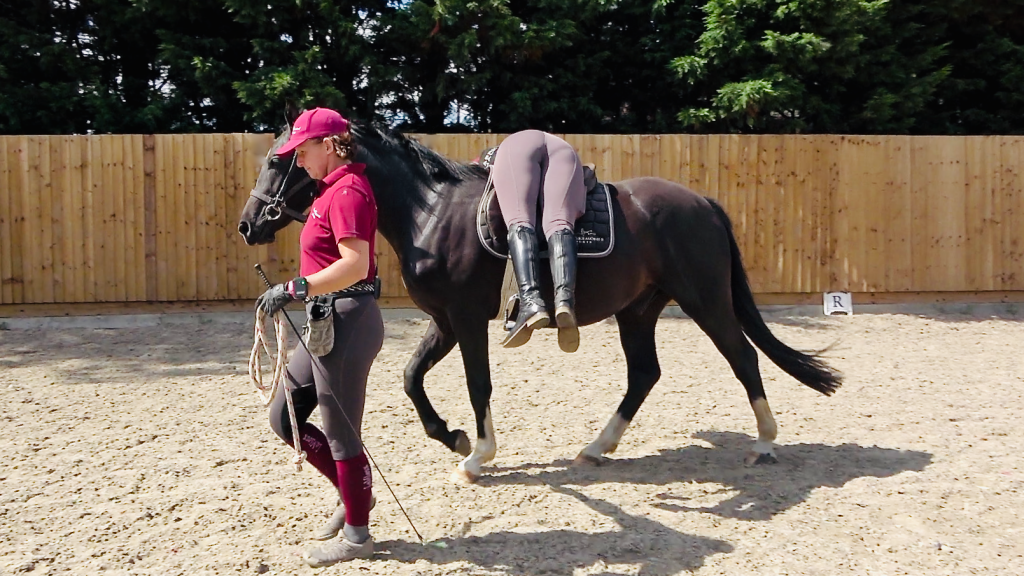
Spring: Lesson 3
On the Move
- Left rein
- Confidence
- Rider safety
- Relaxation
- Pressure
- Feet out of stirrups
- Leaning over
- Mounting routine
It is amazing how our horses are so willing to carry a rider on their backs.
Before we start, we make sure our triangle and mounting block are set up in the same position each time - remember 'horses think in pictures' so it is important to make sure the picture is always the same so that your horse can easily learn and repeat the pattern.
Now if you think about it - and this always amazes me - it is really quite odd for a horse to carry the weight of a rider, especially when they start walking. So, understandably they can sometimes be a little bit unsure at first. The reason we start walking whilst 'leaning over' rather than fully mounted and sitting astride, is so that if there were any wobbles, Maz can simply drop down onto her feet relatively safely. You will see this is where our trusty triangle comes in. You will see Raffles has already learned the pattern - he knows the answer before we even ask the question!
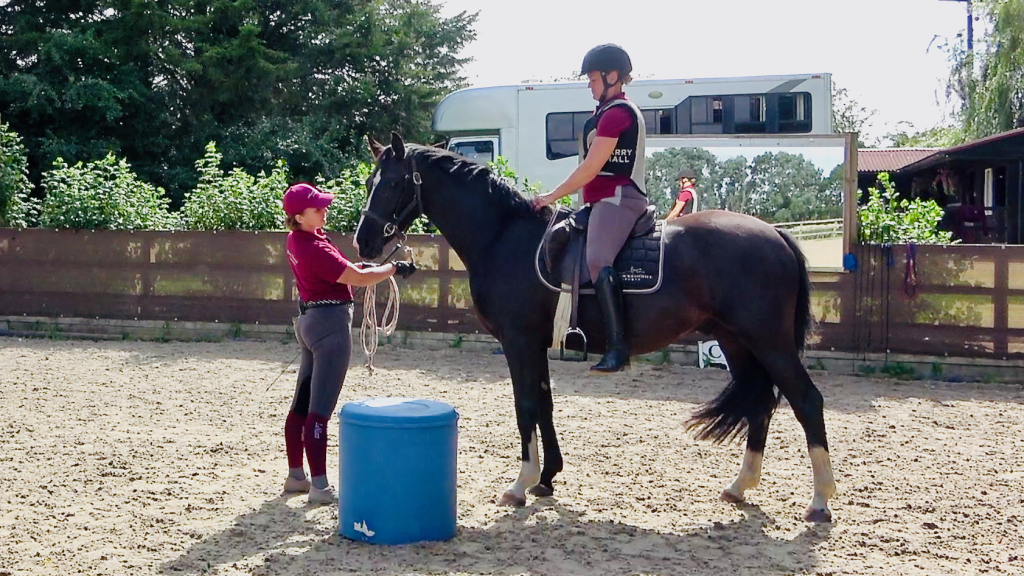
Spring: Lesson 4
All Aboard!
- Rider safety
- Pressure and release
- Knowing your horses mood
- Behaviour patterns
- Trust your own instinct
Oops! We abandon our first attempt due to weather and try again next day.
Finally we are ready to fully mount Raffles and our aim is to target all 3 cones on the triangle. However, as you’ll see it’s windy and Raffles gets a little bit tense. So we make a judgement call to keep everyone safe and quit while we're ahead. This is an important lesson in itself!
The next day is much calmer - so we try again. Backing a young horse can be tricky, and we are often told it is best ‘left to the experts’ but with the right support every sensible horse owner can make a good job of it. For most of us our horses are a part of our family. We are with them every day and have built up mutual trust and a bond with them. We are their experts! Get to know your horses’ moods and behaviour patterns you will instinctively know - better than any ‘expert’ - when it’s sometimes best to leave things for another day.
Downloadable Quick-Reference Cards
Lesson:Safe Zone

Safety first! If you’re on the ground, wear gloves and a safety helmet. Your rider, should be wearing a safety helmet, gloves and body protector.

Your horse should be wearing a fl at head collar, a headslip with simple snaffle bit on top, and a saddle which has been professionally fitted to your horse.

Set up your arena with a mounting block and 2 x cones on a triangle approx 10 - 15m apart. Choose an area where your horse feels secure.

Point in the direction of the fi rst cone on the triangle and walk towards it. As you reach the cone point at it to cue your horse to ‘target’ it - ‘tsk’ & reward.

Follow the triangle pattern, targeting each cone, and then halt at the mounting block - ‘tsk’ & reward.
REMEMBER:
The ‘picture’ changes when you change rein, so stick to the left rein only as this helps your horse learn the pattern and become more confident.
The ‘picture’ changes when you change rein, so stick to the left rein only as this helps your horse learn the pattern and become more confident.
- Spring
Summer Season
Summer is here in full bloom and Raffles is making great progress. In this season your horse will learn to 'tune in' to the rider's aids and take their first trot steps on the lunge under saddle.
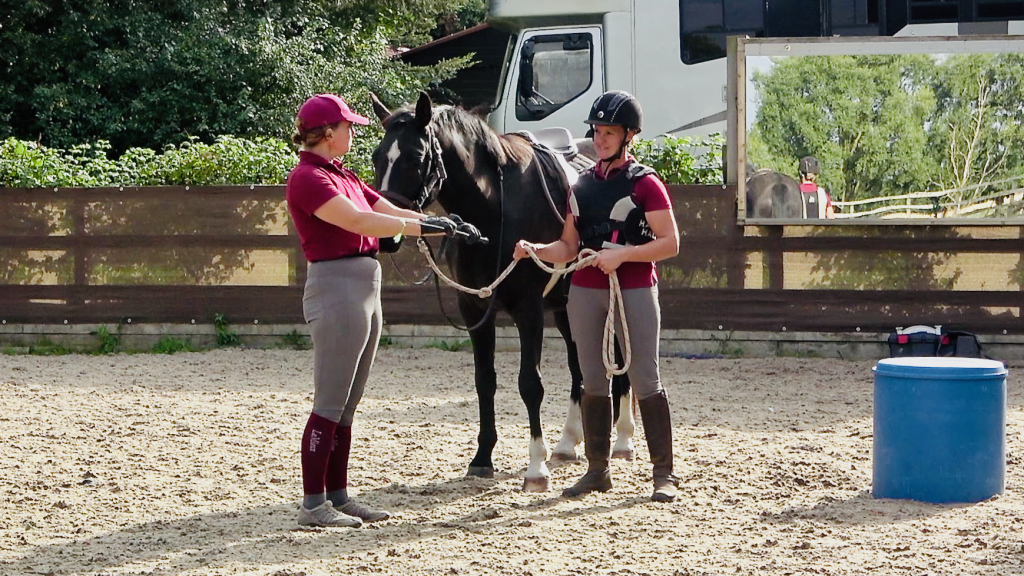
Summer: Lesson 1
Rider Aids
- Introducing rider aids
- Lightness
- Learning how horses think in pictures
- Overlaying groundwork cues
Raffles learns to listen and react to 'light' aids, right from the beginning.
As we’ve seen from the previous lessons, horses 'think in pictures'. Raffles already knows what the 'stop & go' picture looks like on the ground when we give him a clear 'cue'. Now we're ready to start 'overlaying' the rider aids. We start with the 'stop aid'. Our rider, Maz, must first have a 'loopy' rein with no contact. Then, in coordination with the 'stop' ground cue' she lifts the bit up into the corners of Raffles' mouth to 'block' and then quickly releases. The release is important as we are training a 'light' aid. It's not about using physical force to stop your horse!
Next the 'go aid' again in coordination with the ground cue, Maz gently squeezes with her calf to go forward. Raffles is joining up the dots and soon won't need the ground cues at all. He is learning right from the beginning to listen and react to light rider aids.
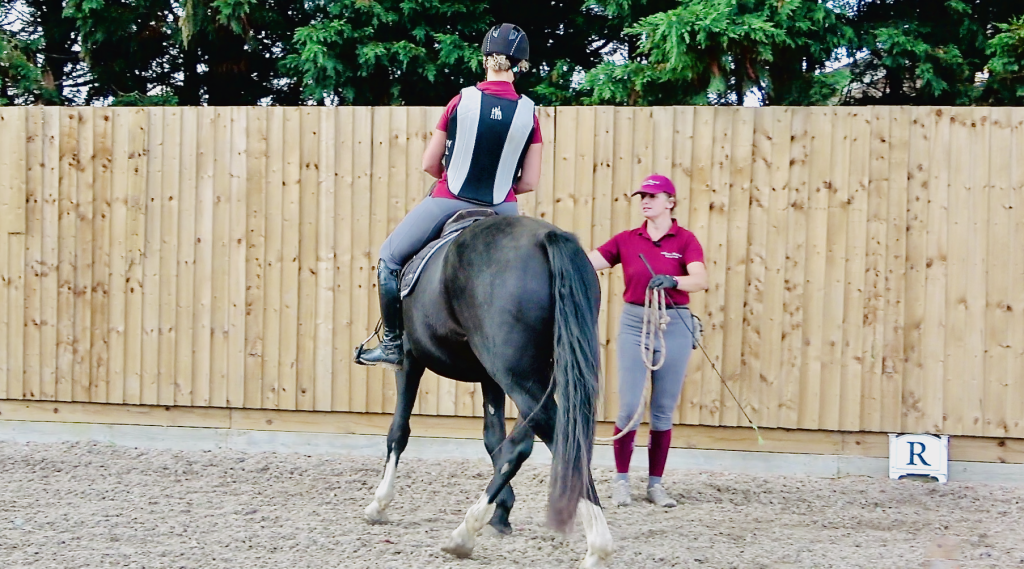
Summer: Lesson 2
Tuning In
- Clingy behaviour
- Lack of confidence on right rein
- Natural asymmetry
- Falling in
- Benefits of turn about fore
Raffles is a little clingy on the right rein, but his 'turn on the fore' is super!
In this lesson you will see Raffles is less confident on the right rein. As explained in the groundwork program this is perfectly normal, so it takes a little longer to lengthen the lunge line and step further away, but gradually we will get there. On the plus side, he learns to 'step laterally' and change rein in a lovely 'turn on the fore' which can help us to accomplish so much in the overall training scheme.
From a rider perspective, 'turn on the fore' is important as it creates an awareness of the horse’s centre of balance. Downward transitions become better balanced since the horse will accept support from your inner leg and not tip to the forehand, canter departs will improve because preparation is clearer, and as an added bonus for later on in the future, it is a great way to develop walk pirouettes… all in good time!
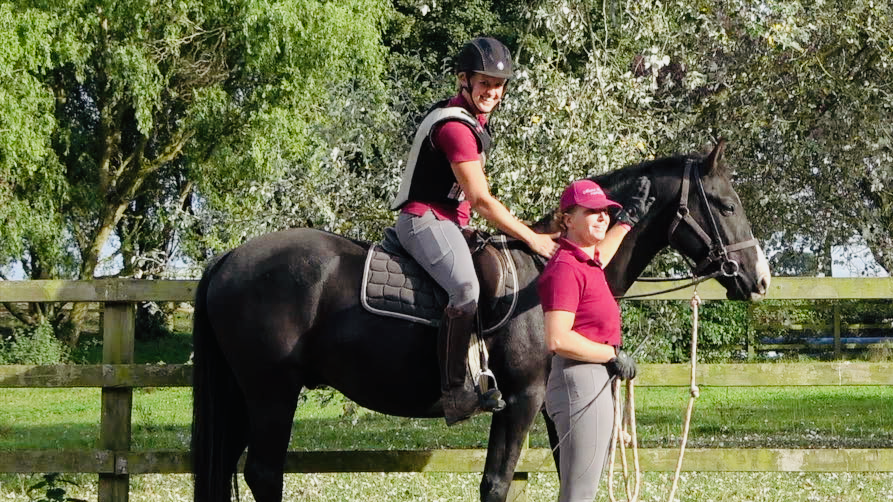
Summer: Lesson 3
Lunge Walk
- Variable reinforcement rewarding the smallest try
- Pattern recognition
- Pressure and release
- Motivation
An important insight into how to keep your horse motivated in their training.
Now that Raffles is feeling confident on both reins, we can start lunge work. You will notice he is gradaully getting fitter and can sustain the work for longer spells, so it's time to start reducing the rewards. So far in the program we have been using one reward for every one desired behaviour - this is called a 'one for one'. We are rewarding the ‘smallest try’ in the beginning. Then gradually we can up the criteria and progress to 'two for one' - so that is two 'correct behaviours' for one reward.
Now at first, when you miss a reward out - your horse might say; 'hey I did it! Where's my reward? OK I'll try again'. Then eventually you can move onto 'three for one's' etc. This is called 'variable reinforcement'. If you want your horse to be super motivated and 'shouting' out all the right answers then this method really works.
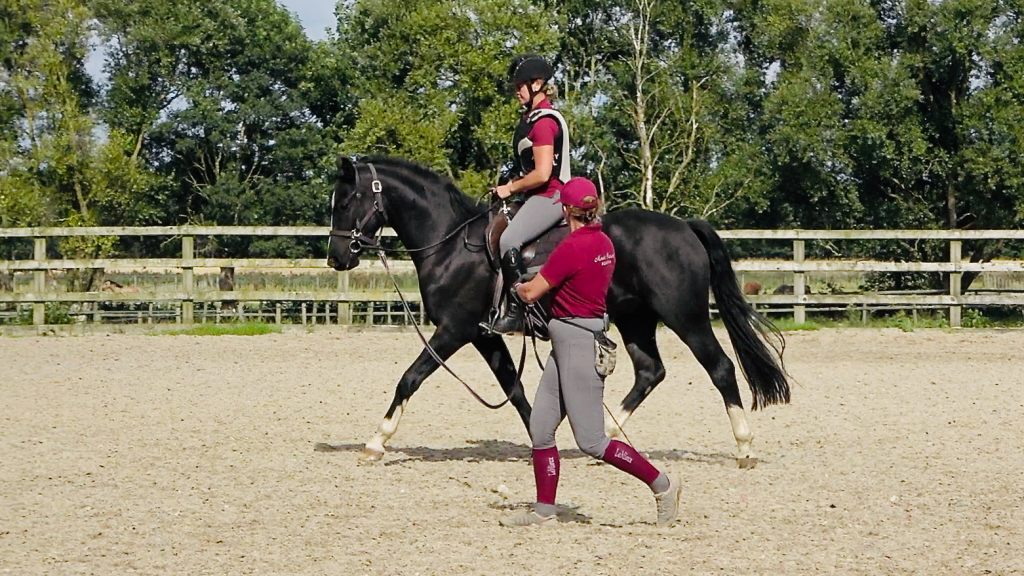
Summer: Lesson 4
Lunge Trotwork
- Trot work
- Incremental training
- Building confidence
- Developing ambidexterity
Finally Raffles is ready to take his first trot steps under saddle - clever boy!
Finally Raffles is ready to take his first trot steps under saddle! We need to be careful to keep the circle nice and large, otherwise he will struggle to balance. You will see he isn't as confident at first on the right rein, so we had to go back a step and help him out with the walk halt transitions. Remember this is normal! You will notice that most horses tend to be less confident in their right eye and this partly due to us doing everything with them on the left hand side; mounting, leading etc.
A good tip to practice in your day to day training is to do more leading on the right hand side, pick out feet starting on the right, groom on the right side first etc. This will improve your ground skills and liberty connection and help your horse be less worried - especially on that less confident right rein when they are ridden.
Downloadable Quick-Reference Cards
Lesson:Rider Aids

As a pre-requisite, your horse must fi rst understand the ‘go and whoa’ cues learned in the Young Horse Groundwork program. Revisit this lesson first.

Next go through the ‘mounting routine’. Then repeat the ‘go and whoa’ lesson with the rider on board. Your rider is completely passive at this stage.

Next ‘overlay' the rider aids, starting with the ‘whoa’ aid. In coordination with your ground cue, the rider blocks with the reins, and then releases.

To change rein ‘turn about the fore’ - ask your rider to stay passive for this whilst you cue the turn from the ground. Repeat the ‘whoa aid’ on both reins

Next ‘overlay’ the 'go aid’. In coordination with your ground cue, the rider gently squeezes with the calf to go forward.
REMEMBER:
Soon your horse won’t need the ground cues as they will be listening and responding to light rider aids.
Soon your horse won’t need the ground cues as they will be listening and responding to light rider aids.
- Summer
Autumn Season
Our training is starting to 'bear fruit' in this Autumn Season, as more complex patterns begin to take shape. Your horse will learn to work independently, without the lunge line.

Autumn: Lesson 1
Corkscrew Pattern
- Session plan
- Clear communication
- Light consistent contact
- Stop & go aids
- Pattern recognition
Raffles recognises this pattern - he knows what to do with a corkscrew!
Horses are the masters when it comes to 'pattern recognition'. Raffles has already learned the ‘cork screw’ pattern on the ground, where we move the circle up the arena, adding in halt transitions at markers on the track as we go along, in a ‘corkscrew shape’. Now we are ready to try it under saddle.
Our aim is to work up and down the arena in walk first and then in trot, and then repeat the same on the other rein. This might seem obvious, but before you get started, it is important to always talk to your rider and tell them what the aim is for the session. Having a clear plan will give your rider confidence, which obviously translates to your horse, keeping them calm and relaxed. Also, as everyone knows what you are aiming for, you won’t be tempted to get greedy and try to do too much!

Autumn: Lesson 2
Sustaining Trot
- Sustaining trot
- Developing fitness
- Clear communication
- Clumsiness
- Tripping
- Lack of focus
It's time to build up stamina. Raffles becomes less clumsy as he gets fitter.
This lesson is a progression of the previous ‘corkscrew’ exercise. This time we are aiming to sustain the trot and make a continuous 'corkscrew pattern' - without the halts. At times Raffles anticipates halting at the markers, so we must be clear with our cues and keep our 'energy up' when approaching the letters.
You may find that your horse seems a bit clumsy and they might stumble at times - just like we trip over our own toes sometimes, for no reason at all. Assuming you have ticked all the normal heath check boxes, hoof care, etc. the reason for this is either horse is not paying attention or he’s tired. Muscle fatigue can cause stumbling and foot dragging. This is really common young horses as they are unfit at this stage, and they are obviously unused to carrying a rider... so don't panic!

Autumn: Lesson 3
Independent Walk
- Using liberty training to help independent ridden work
- Quality forward walk
- Clear cues
All our training is finally paying off as Raffles and Maz safely fly solo!
We start this lesson on the lunge, just to make sure Raffles is 'tuned in' and listening first. Then, drumroll... we are finally ready to finally unclip the lunge line! If you were expecting something exciting to happen, you will be disappointed as Raffles doesn't even notice, which is exactly what we want!
What we’re looking for is a nice active walk - think about how you would walk to the bus stop to get there on time… you don’t want to miss the bus! Only add the halt transitions when you have a really good quality walk, otherwise if your horse is ambling along, he may wobble off track and everything will become unclear.
Once Raffles is nicely forward, we make a halt transition at a marker, with our stop aid overlayed as before. When we are ready to move off, Maz gives a light squeeze with her calf at the same time as the go cue from the ground. If Raffles trots by mistake, Maz tries not to grab the reins (easier said than done!) and trusts that we will quietly bring him back to walk using our liberty training as learned in the 'Young Horse Groundwork' program.
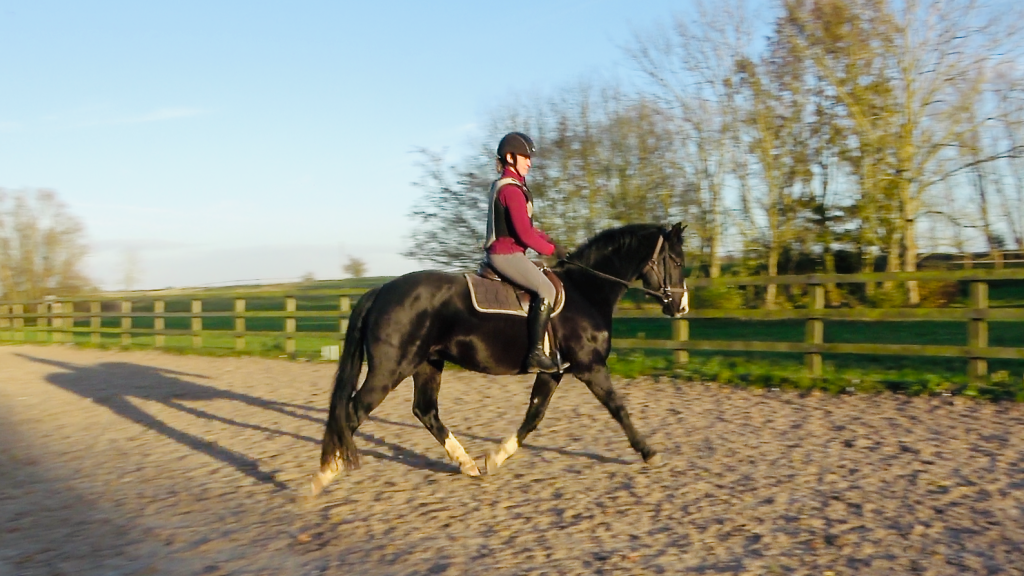
Autumn: Lesson 4
Independent Trot
- Consistent cues
- Patience
- Baby steps
- Learning a language
- Fluency in understanding aids.
We're up and running! Raffles and Maz progress to independent trot work.
Finally we are ready to start independent trot work under saddle. At this point Raffles is approximately 50% fluent in understanding the rider aids so he might get a little bit sticky at times. If that happens, the best thing our rider, Maz, can do is sit quietly and let us come and help with our cues from the ground.
Your rider might feel 'like a bit of a lemon' sitting there doing nothing, but there is no point pulling or kicking as your horse just doesn’t understand. It would be like someone asking you a question in a foreign language and then when you look at them blankly they just keep shouting the same question louder and louder… no matter how loud they shout you still don’t understand! It's the same for your horse. They only understand A, B, C at the moment, but soon they will be able to put together whole sentences.
Downloadable Quick-Reference Cards
Lesson:Corkscrew Pattern

As a pre-requisite, your horse should have already learned the ‘corkscrew pattern’ on the ground. Now you are ready to add the rider.

As you set o ff from the mounting block, cue with your arm pointing forward as your rider overlays the ‘go aid’ by lightly squeezing with the calf.

Your rider maintains a light contact, and overlays the ‘stop aid’ by applying pressure on the bit to ‘block’ and then ‘release’ back to a light contact.

Follow the ‘corkscrew pattern’ in walk, up and down the arena. Focus on getting your cues in sync with your rider’s aids as you halt at each marker.

Next progress to trot. Make sure you give your rider warning if you ‘miss out’ a marker, and when you intend halting, so you are in sync. Repeat on both reins.
REMEMBER:
Always tell your rider what the aim is for the session. Having a clear plan will give your rider confidence, which translates to your horse.
Always tell your rider what the aim is for the session. Having a clear plan will give your rider confidence, which translates to your horse.
- Autumn
Winter Season
Finally, this is where it all comes together. Your horse will learn 'shoulder control' to help with steering, and to keep us all warm this chilly winter season, we progress to canter work!
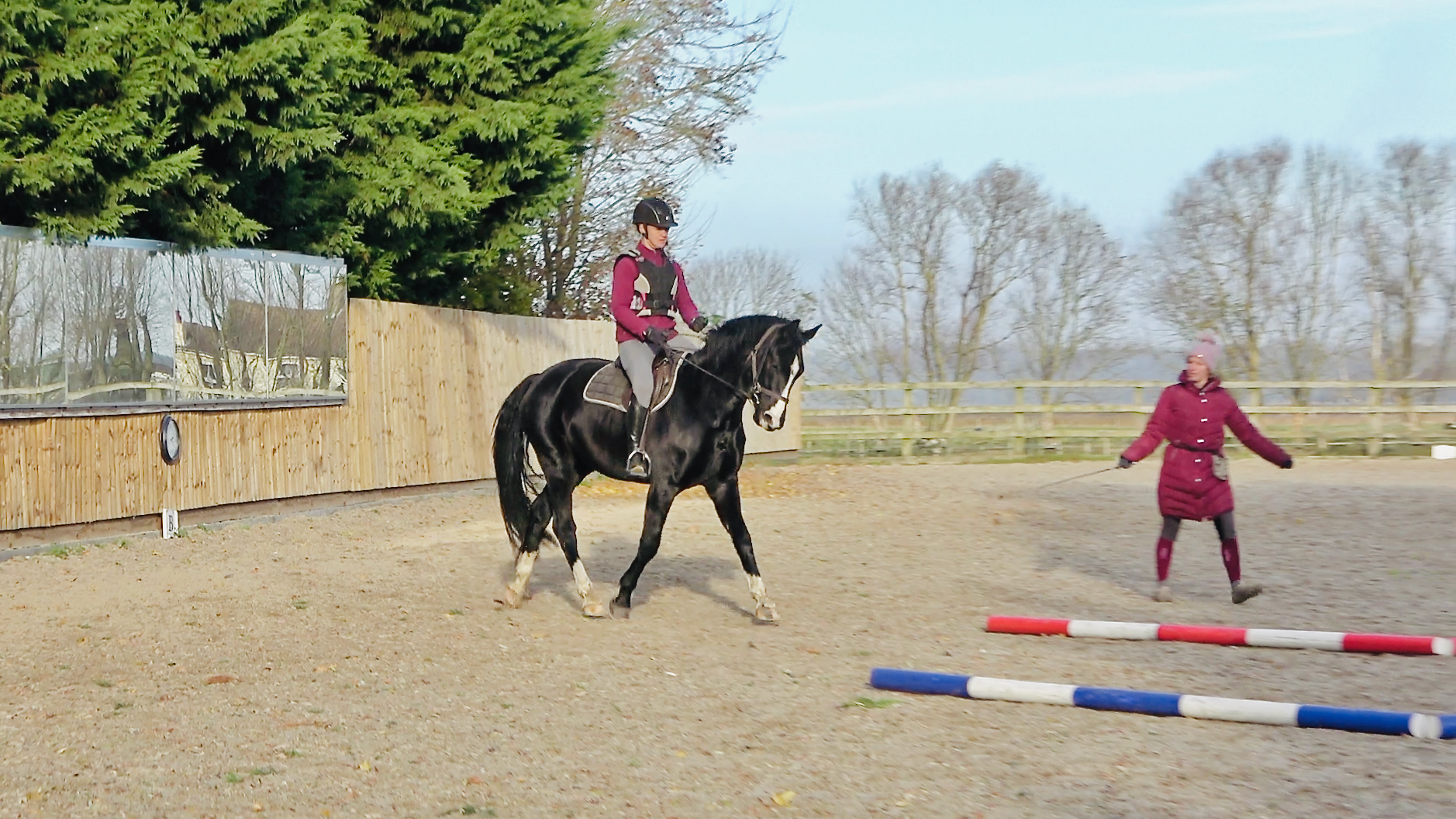
Winter: Lesson 1
Shoulder Control
- Shoulder control
- Turning aids
- Chevron poles
- Weight aids
- Loss of balance
- Falling thorugh turns
We are ready to start the canter work, but first we need to learn how to steer!
In the 'Young Horse Groundwork' program we learned that pulling on the inside rein to turn your horse is a big no no! In this lesson, we are going to train Raffles the correct turning aids, from the very beginning, keeping the neck straight and turning the outside shoulder. This will prevent him losing balance and falling through the turn.
We start with just a few steps first at halt, and then progress to walk and finally trot through ground poles which are set out like 'chevrons' to help as a visual aid. Once Raffles successfully turns through the poles, without falling through the shoulder, Maz then uses her ‘weight aids’ to ride straight, by putting a little bit of weight into the outside stirrup. This shifts the centre of gravity which Raffles must stay directly under in order to stay balanced - so he will then travel straight forward up the track.

Winter: Lesson 2
Canter Transition
- Passive rider
- Canter aids
- Building up sitting trot 'bounces'
- Rider weight aids
- Strategic use of arena
Hooves up if you struggle with sitting trot? Don't worry, you're not alone!
Our plan in this lesson is to start the canter transitions on a circle at the 'A' end of the arena. But before we do that, as a warm up and to prepare Raffles for what’s to come, the first thing we need to do is build up some 'sitting trot' steps - as this is the first thing we do as a rider when we ask for canter. We start with just sitting for 2 bounces then we increase to 4 bounces and gradually build up to 6 bounces and so on.
By the way, anyone who struggles as a rider to 'sit to the trot' this is a good way to practice… so pay attention! Once Raffles is happy with the sitting trot steps, we ask for the canter transition over the centre line. For now our rider will stay passive - so no other canter aids at this point. Later on we will overlay the rider aids in exactly the same way as we did previously in the trot work.
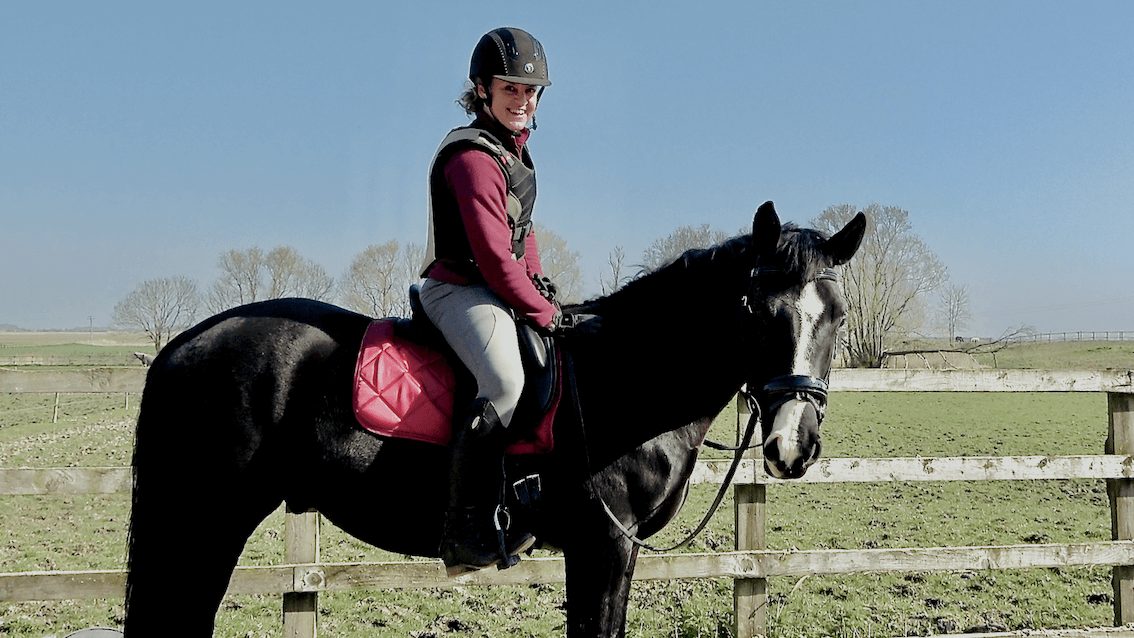
Winter: Lesson 3
Introducing Canter Aids
- Active ride
- The old masters saying
- Testing our training
- Work on the problem not the symptom
The Old Masters used to say; ‘explain in walk, train in trot, test in canter.'
In this lesson our rider starts to take control, so instead of being 'passive', Maz becomes 'active' giving a clear aid for canter. She gives the aid in coordination with the ground cues, so we are overlaying the rider aids, in exactly the same way as before.
The Old Masters used to say ‘explain in the walk, train in the trot and test in the canter'. So the canter really is a ‘test’ of all of our work so far. If you have a problem, then the best idea is to think about what part of your foundation is the weak point. If your horse lacks impulsion then go back to the lunge and work on sharpening up the reactions to your cues. Just going around and around in canter won’t improve the canter. Your horse will get tired and stressed and then he will stop learning. You need to work on the problem - not the symptom, which is presenting itself in the canter.
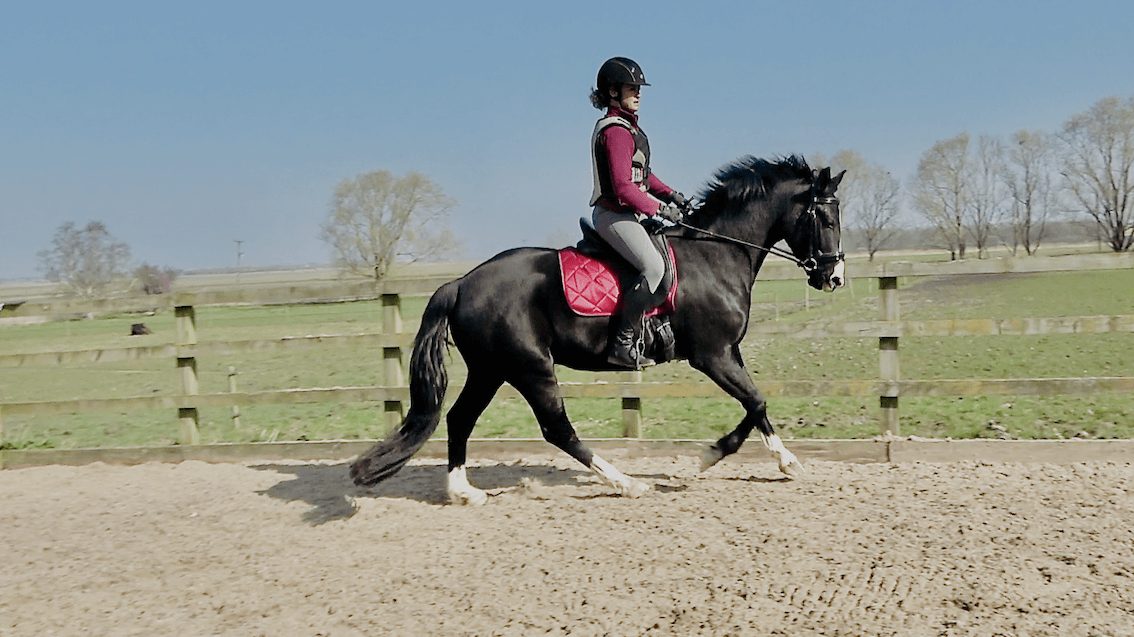
Winter: Lesson 4
Independent Canter
- Explaining the pattern in trot
- Building up in stages
- Learning by repetition
- Pattern recognition
- Stamina
- Confidence
What an amazing foundation to start his career. Raffles you are a star!
We are finally ready for our grand finale - working independently in canter under saddle! We start by warming up in trot on a 'lozenge pattern' so that Raffles will know where he is going when we ask for the canter! It's important to build the canter up in stages so we start with the canter transition at the 'A' end - exactly as learned previously. After cantering 3/4 of a circle he will then travel down the long side of the arena.
Now, at some point, depending on your horse's fitness they will drop into trot. When this happens, the plan is to sustain the trot and continue on the 'lozenge pattern' returning back to the 'A' marker where you started, then halt and reward. In time your horse will learn, and become motivated to stay in the canter, in order to reach this point for a rest and reward. What a fantastic journey this has been - well done Maz & Raffles!
Downloadable Quick-Reference Cards
Lesson:Shoulder Control

Start by using your ground cues to help ‘yield’ the shoulders a few steps. The rider focuses on keeping the neck straight and turning the outside shoulder.

Next progress to the ‘chevron’ poles in walk with help from the ground first, then independently. Then set the poles wider approx 4m and repeat in trot.

Once your horse has learned how to turn correctly through the poles, they are ready to start to working large, and gradually become more independent.

By putting a little more weight into the outside stirrup, to shift the centre of gravity, your horse will stay under the rider and travel straight up the track.

Give your rider the treat bag to reward from the saddle. Using the inside hand has an added bonus as your horse will learn to fl ex the poll to the inside.
REMEMBER:
Pulling on the inside rein is a big no no! Teaching your horse the correct turning aids is hugely important in order to keep their balance, and confidence intact.
Pulling on the inside rein is a big no no! Teaching your horse the correct turning aids is hugely important in order to keep their balance, and confidence intact.
- Winter
